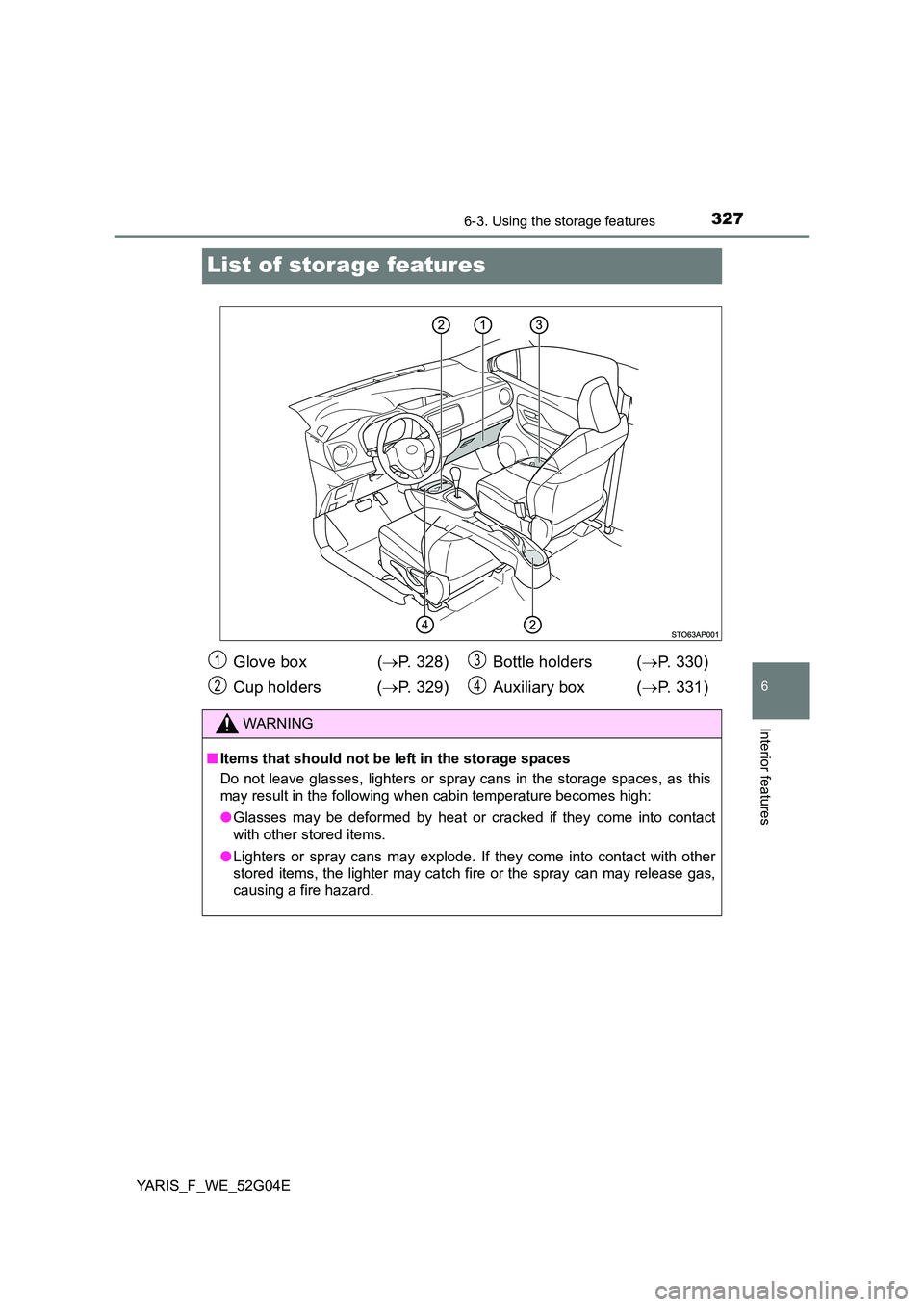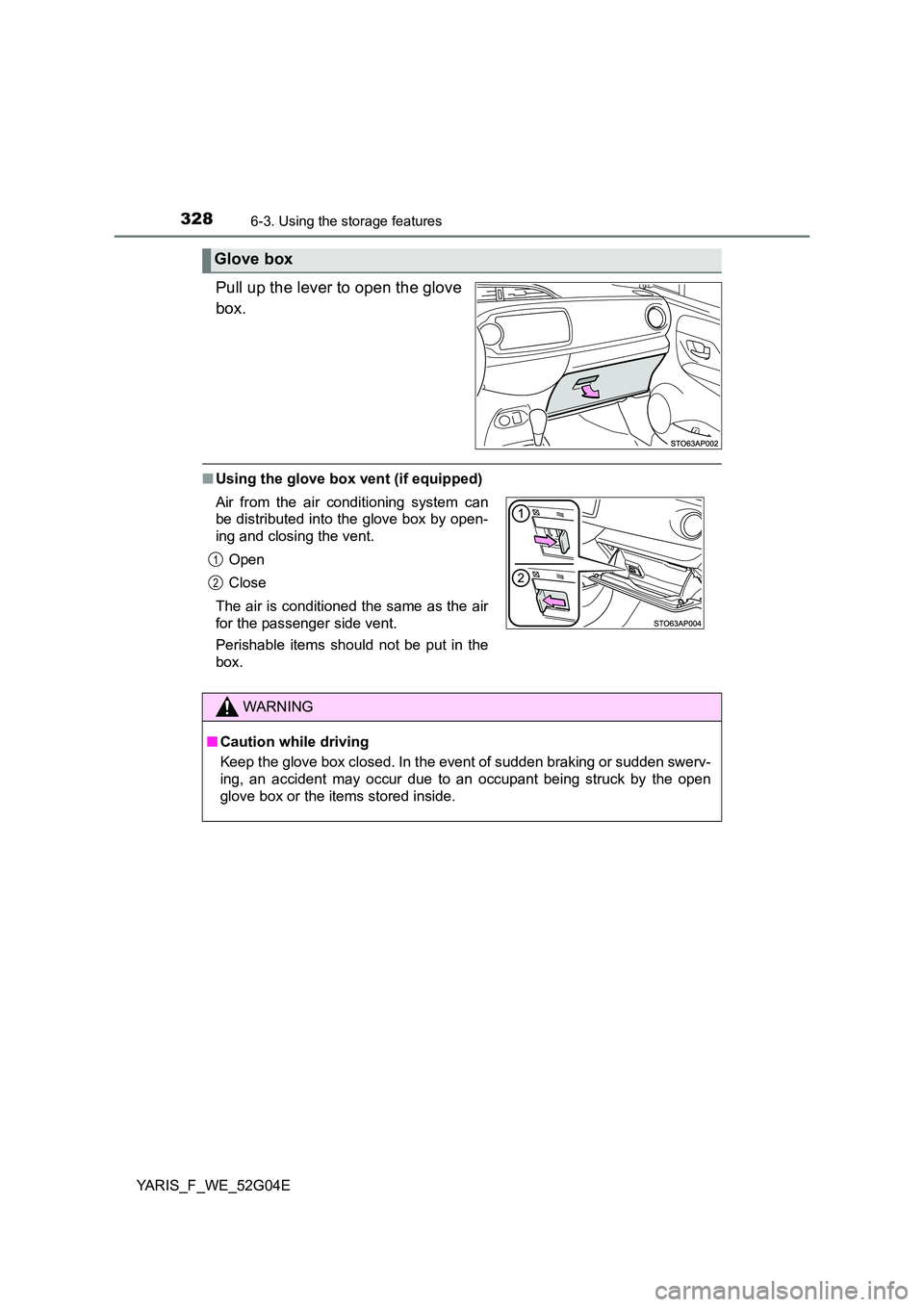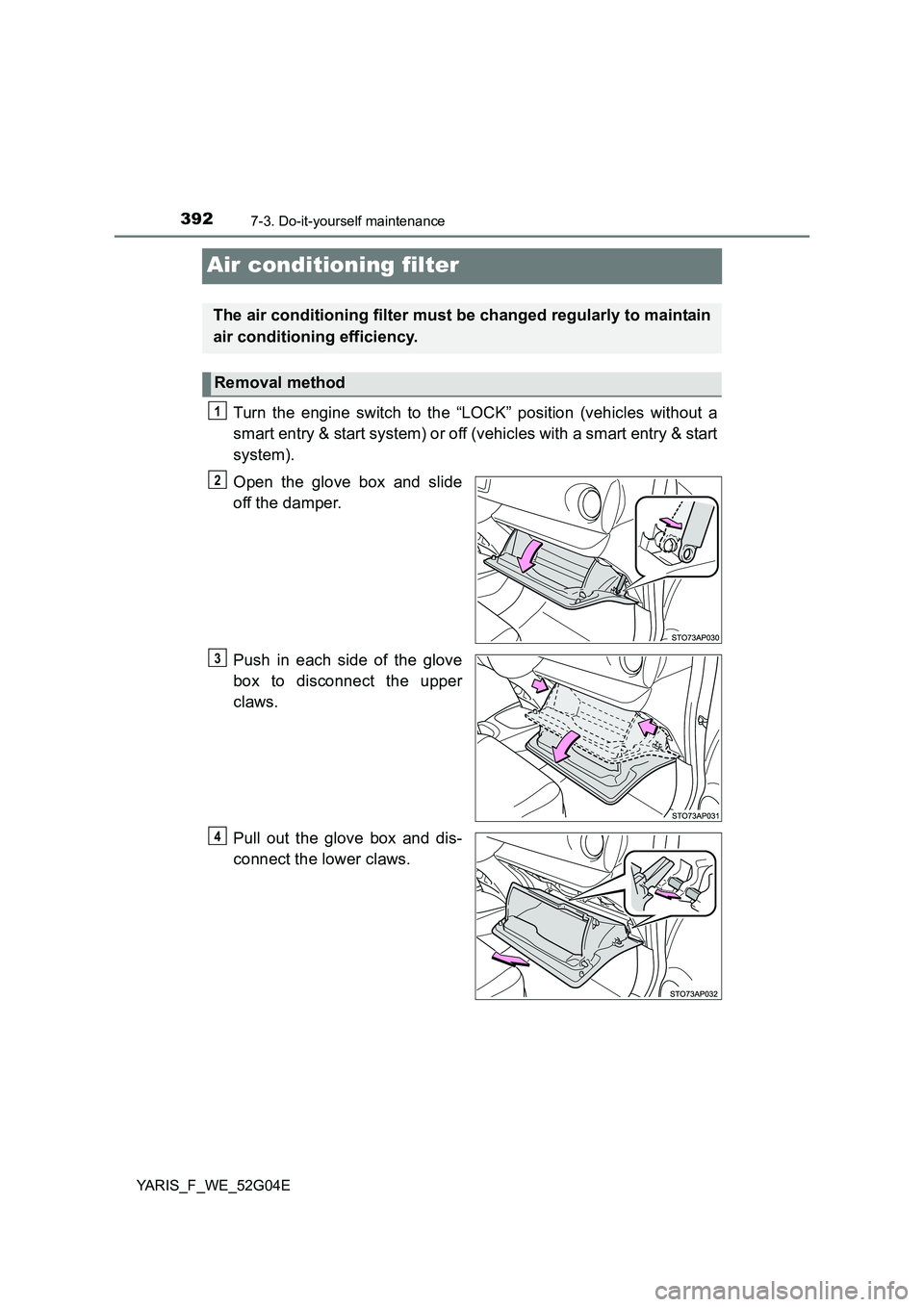2015 TOYOTA YARIS HATCHBACK glove box
[x] Cancel search: glove boxPage 4 of 540

TABLE OF CONTENTS4
YARIS_F_WE_52G04E
6-1. Using the air conditioning
system and defogger
Manual air conditioning
system .............................306
Automatic air conditioning
system .............................313
Power heater .....................321
Seat heaters ......................323
6-2. Using the interior lights
Interior lights list .................325
• Interior light ....................325
• Personal lights ...............326
6-3. Using the storage features
List of storage features ......327
• Glove box ......................328
• Cup holders ...................329
• Bottle holders ................330
• Auxiliary box ..................331
Luggage compartment
features............................332
6-4. Using the other interior
features
Other interior features ........335
• Sun visors ......................335
• Vanity mirrors ................335
• Portable ashtray ............336
• Cigarette lighter .............337
• Power outlet ..................338
• Armrest ..........................339
• Panoramic roof shade ...339
• Assist grips ....................340
7-1. Maintenance and care
Cleaning and protecting
the vehicle exterior .......... 342
Cleaning and protecting
the vehicle interior ........... 345
7-2. Maintenance
Maintenance
requirements ................... 348
7-3. Do-it-yourself maintenance
Do-it-yourself service
precautions ..................... 351
Hood.................................. 354
Positioning a floor jack ...... 356
Engine compartment ......... 358
Tires .................................. 373
Tire inflation pressure........ 387
Wheels .............................. 389
Air conditioning filter .......... 392
Wireless remote control/
electronic key battery ...... 394
Checking and replacing
fuses ............................... 397
Light bulbs ......................... 403
6Interior features7Maintenance and care
Page 133 of 540

1333-2. Opening, closing and locking the doors
3
Operation of each component
YARIS_F_WE_52G04E
■ Notes for the entry function
● Even when the electronic key is within the effective range (detection areas),
the system may not operate properly in the following cases:
• The electronic key is too close to the window or outside door handle, near
the ground, or in a high place w hen the doors are locked or unlocked.
• The electronic key is on the inst rument panel, luggage cover (if equipped)
or floor, or in the door pockets, glove box, accessory box of the instru-
ment panel, or in/near the front cup holder when the engine is started or
engine switch modes are changed.
● Do not leave the electronic key on top of the instrument panel or near the
door pockets when exiting the vehicle. Depending on the radio wave recep-
tion conditions, it may be detected by the antenna outside the cabin and the
door will become lockable from the outside, possibly trapping the electronic
key inside the vehicle.
● As long as the electronic key is within the effective range, the doors may be
locked or unlocked by anyone.
● Even if the electronic key is not inside the vehicle, it may be possible to start
the engine if the electronic key is near the window.
● The doors may unlock if a large amount of water splashes on the door han-
dle, such as in the rain or in a car wash when the electronic key is within the
effective range. (The door will automatically be locked after approximately
30 seconds if the doors are not opened and closed.)
● Gripping the door handle when wearing a glove may not unlock the door.
● If the wireless remote control is used to lock the doors when the electronic
key is near the vehicle, there is a possibility that the door may not be
unlocked by the entry function. (Use the wireless remote control to unlock
the doors.)
● A sudden approach to the effective range or door handle may prevent the
doors from being unlocked. In this case, return the door handle to the origi-
nal position and check that the doors unlock before pulling the door handle
again.
■ Notes for locking the doors
● Touching the door lock sensor while wearing gloves may delay or prevent
lock operation. Remove the gloves and touch the lock sensor again.
● If the door handle becomes wet while the electronic key is within the effec-
tive range, the door may lock and unlock repeatedly. Place the key in a posi-
tion 2 m (6 ft.) or more separate from the vehicle while the vehicle is being
washed. (Take care to ensure that the key is not stolen.)
● If the electronic key is inside the vehicle and a door handle becomes wet
during a car wash, a buzzer will sound outside the vehicle. To turn off the
alarm, lock all the doors.
● The lock sensor may not work properly if it comes into contact with ice,
snow, mud, etc. Clean the lock sensor and attempt to operate it again.
Page 169 of 540

1694-1. Before driving
4
Driving
YARIS_F_WE_52G04E
WARNING
■If you hear a squealing or scraping noise (brake pad wear indicators)
Have the brake pads checked and replaced by any authorized Toyota
dealer or repairer, or another dul y qualified and equipped professional as
soon as possible.
Rotor damage may result if the pads are not replaced when needed.
It is dangerous to drive the vehicle when the wear limits of the brake pads
and/or those of the brake discs are exceeded.
■ When the vehicle is stopped
● Do not race the engine.
If the vehicle is in any gear other than P (Multidrive) or N, the vehicle may
accelerate suddenly and unexpectedly, causing an accident.
● On vehicles with a Multidrive, in order to prevent accidents due to the vehi-
cle rolling away, always keep depressing the brake pedal while the engine
is running, and apply the parking brake as necessary.
● If the vehicle is stopped on an incline, in order to prevent accidents caused
by the vehicle rolling forward or backward, always depress the brake pedal
and securely apply the parking brake as needed.
● Avoid revving or racing the engine.
Running the engine at high speed while the vehicle is stopped may cause
the exhaust system to overheat, which could result in a fire if combustible
material is nearby.
■ When the vehicle is parked
● Do not leave glasses, cigarette lighters, spray cans, or soft drink cans in
the vehicle when it is in the sun.
Doing so may result in the following:
• Gas may leak from a cigarette lighter or spray can, and may lead to a
fire.
• The temperature inside the vehicle may cause the plastic lenses and
plastic material of glasses to deform or crack.
• Soft drink cans may rupture, causing the contents to spray over the
interior of the vehicle, and may also cause a short circuit in the vehicle’s
electrical components.
● Do not leave cigarette lighters in the vehicle. If a cigarette lighter is in a
place such as the glove box or on the floor, it may be lit accidentally when
luggage is loaded or the seat is adjusted, causing a fire.
Page 305 of 540

305
6Interior features
YARIS_F_WE_52G04E
6-1. Using the air conditioning
system and defogger
Manual air conditioning
system ............................. 306
Automatic air conditioning
system ............................. 313
Power heater ..................... 321
Seat heaters ...................... 323
6-2. Using the interior lights
Interior lights list................. 325
• Interior light.................... 325
• Personal lights ............... 326
6-3. Using the storage features
List of storage features ...... 327
• Glove box ...................... 328
• Cup holders ................... 329
• Bottle holders ................ 330
• Auxiliary box .................. 331
Luggage compartment
features............................ 332
6-4. Using the other interior
features
Other interior features ........ 335
• Sun visors...................... 335
• Vanity mirrors ................ 335
• Portable ashtray ............ 336
• Cigarette lighter ............. 337
• Power outlet .................. 338
• Armrest .......................... 339
• Panoramic roof shade ... 339
• Assist grips .................... 340
Page 327 of 540

3276-3. Using the storage features
6
Interior features
YARIS_F_WE_52G04E
List of storage features
Glove box (P. 328)
Cup holders ( P. 329)
Bottle holders ( P. 330)
Auxiliary box ( P. 331)
WARNING
■Items that should not be left in the storage spaces
Do not leave glasses, lighters or spray cans in the storage spaces, as this
may result in the following when cabin temperature becomes high:
● Glasses may be deformed by heat or cracked if they come into contact
with other stored items.
● Lighters or spray cans may explode. If they come into contact with other
stored items, the lighter may catch fire or the spray can may release gas,
causing a fire hazard.
1
2
3
4
Page 328 of 540

3286-3. Using the storage features
YARIS_F_WE_52G04E
Pull up the lever to open the glove
box.
■ Using the glove box vent (if equipped)
Glove box
Air from the air conditioning system can
be distributed into the glove box by open-
ing and closing the vent.
Open
Close
The air is conditioned the same as the air
for the passenger side vent.
Perishable items should not be put in the
box.
WARNING
■ Caution while driving
Keep the glove box closed. In the event of sudden braking or sudden swerv-
ing, an accident may occur due to an occupant being struck by the open
glove box or the items stored inside.
1
2
Page 392 of 540

3927-3. Do-it-yourself maintenance
YARIS_F_WE_52G04E
Air conditioning filter
Turn the engine switch to the “LOCK” position (vehicles without a
smart entry & start system) or off (vehicles with a smart entry & start
system).
Open the glove box and slide
off the damper.
Push in each side of the glove
box to disconnect the upper
claws.
Pull out the glove box and dis-
connect the lower claws.
The air conditioning filter must be changed regularly to maintain
air conditioning efficiency.
Removal method
1
2
3
4
Page 467 of 540

4678-2. Steps to take in an emergency
8
When trouble arises
YARIS_F_WE_52G04E
Connect the bottle to the com-
pressor.
Screw the end of the hose clock-
wise as far as possible.
Check the specified tire inflation
pressure.
Tire inflation pressure is specified
on the label in the glove box.
( P. 509)
Start the engine.
To inject the sealant and inflate
the tire, turn the compressor
switch on.
10
11
12
13